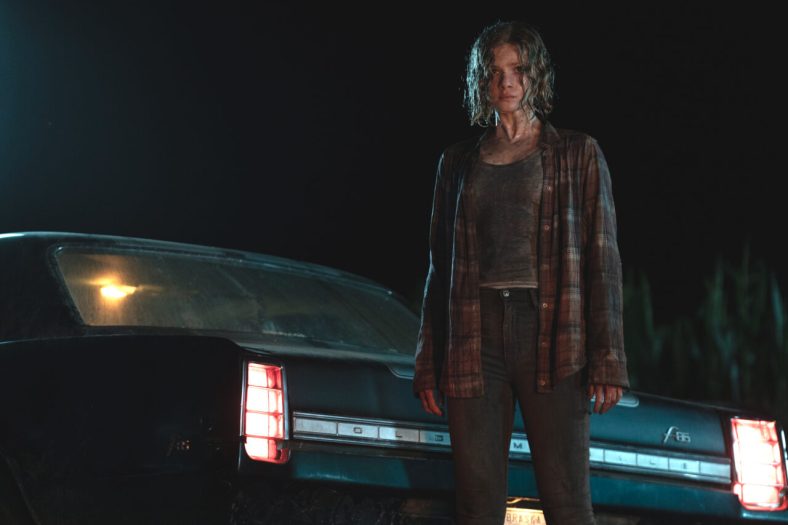‘Children of the Corn’ Review: Reboot, Schmeboot

Kurt Wimmer’s Children of the Corn is, at times, actively hostile toward being a coherent movie. As the eleventh entry in the long-running series—all of which sprang from the corn of Stephen King’s own 1977 short story—there’s nothing in this reimagining with any semblance of urgency or purpose. As horror IPs are buried and revitalized in the genre’s own Pet Sematary, audiences need a strong reason to see them. Halloween, for better or worse, explored the gestating roots of trauma afflicting three generations of women. Scream was a visceral, scathing denouncement of fan culture.
Children of the Corn has nothing to merit its existence. Shelved for several years pending a limited theatrical bow before it premieres on Shudder, Children of the Corn will inevitably be branded one of the worst horror movies of the year. Yet, like He Who Walks Behind the Rows, there’s something inexplicably fascinating about it all. Children of the Corn isn’t good, but it’s never boring.
Opening with a truncated prologue of adolescent homicide, the movie arrives where every Children of the Corn has arrived before. Elena Kampouris’ Boleyn Williams is planning to leave her small Nebraska town to study agriculture and biology. Laboring to make a political point it’s never capable of actualizing, Boleyn worries for her town’s diminished crop yield. She’s certain that both industrialization and climate change are to blame. As the air and soil are polluted with pesticides and fertilizers hostile to growing life, she’s figures it’s science—not small town Americana politics—that can save the crops.
Concurrently, Kate Moyer’s Eden Edwards is menacing everyone she comes across. She wants to walk another kid off a plank into a pile of burning corn husks. Boleyn says no. Eden laughs it off—she was just in a silly, goofy mood. Principally, Eden and the other titular children are Children of the Corn’s biggest detraction. Ostensibly an origin story for how the town fell and the children took over, Children of the Corn is missing an entire act.
By the time the film starts, the children are already corrupted by demonic fertility spirits living among the crops. There’s no regression into evil—they simply already are. Conspicuously, too, no one seems to mind all that much. Boleyn, for instance, encounters a group of children painting the roots with pig blood. She skirts over that weird behavior entirely to instead ask that they escort a journalist en route to town.
There is some value, at least theoretically, in what Children of the Corn wants to argue. In a fractured political landscape, it’s unfair that children are denied civic engagement. Truthfully, the consequences are principally theirs to bear. Boleyn and Eden both best conceptualize this tension, incapable of voting on government subsidies to bury the corn, for instance, despite the economic ramifications proving more dire for their generation, not the present one. Yet, truthfully, Children of the Corn doesn’t really care about that. The movie haphazardly shifts from one scene to the next with no sense of rationality or congruity until the children, as they are wont to do in this series, are massacring the entire town.
That massacre at least galvanizes Children of the Corn to come into focus. Prior to that, the overarching conflict was unclear, playing out more as a procedural Law & Order riff on the material than anything else. There were talks of mock trials, cancel culture, and holding people accountable, though none of it comes to fruition. Instead, the kids round up every adult in town, killing some, saving others, and leaving scorched earth in their wake (off-screen, of course, Children of the Corn has big ideas but little scale to back them up).
Some of the deaths are suitably gruesome, and in its final act, Children of the Corn starts feeling less like a second season of Kid Nation and more like a ridiculous creature feature from Roger Corman’s heyday. Sure, none of it makes sense (these adults could easily, easily take every kid in town on), and everyone behaves pretty badly. But there’s gusto to how firmly committed Children of the Corn is to be so many things at once while barely accomplishing any of them.
Children of the Corn is not a good movie. It’s not a good reboot. In fact, at times, it barely even feels like a finished movie. Yet, amidst all the mangled corpses and monstrous corn deities, there’s fun to be had. The sheer commitment at play is laudable, and the tilt into full-borne creature feature is welcome. There’s dissonance here. I know it’s a bad movie, but I was never bored. A few times, I was even incredulously (and excitedly) shouting at my television. Mileage with its ethanol-fueled terror may vary, but for some, Children of the Corn might well be a camp delight.
-
Children of the Corn
Summary
Children of the Corn never justifies its existence, though beneath the corn, the creature feature heart shines through.

